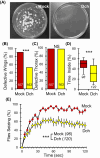Commensal bacteria exacerbate seizure-like phenotypes in Drosophila voltage-gated sodium channel mutants
- PMID: 39231190
- PMCID: PMC11373613
- DOI: 10.1111/gbb.70000
Commensal bacteria exacerbate seizure-like phenotypes in Drosophila voltage-gated sodium channel mutants
Abstract
Mutations in voltage-gated sodium (Nav) channels, which are essential for generating and propagating action potentials, can lead to serious neurological disorders, such as epilepsy. However, disease-causing Nav channel mutations do not always result in severe symptoms, suggesting that the disease conditions are significantly affected by other genetic factors and various environmental exposures, collectively known as the "exposome". Notably, recent research emphasizes the pivotal role of commensal bacteria in neural development and function. Although these bacteria typically benefit the nervous system under normal conditions, their impact during pathological states remains largely unknown. Here, we investigated the influence of commensal microbes on seizure-like phenotypes exhibited by paraShu-a gain-of-function mutant of the Drosophila Nav channel gene, paralytic. Remarkably, the elimination of endogenous bacteria considerably ameliorated neurological impairments in paraShu. Consistently, reintroducing bacteria, specifically from the Lactobacillus or Acetobacter genera, heightened the phenotypic severity in the bacteria-deprived mutants. These findings posit that particular native bacteria contribute to the severity of seizure-like phenotypes in paraShu. We further uncovered that treating paraShu with antibiotics boosted Nrf2 signaling in the gut, and that global Nrf2 activation mirrored the effects of removing bacteria from paraShu. This raises the possibility that the removal of commensal bacteria suppresses the seizure-like manifestations through augmented antioxidant responses. Since bacterial removal during development was critical for suppression of adult paraShu phenotypes, our research sets the stage for subsequent studies, aiming to elucidate the interplay between commensal bacteria and the developing nervous system in conditions predisposed to the hyperexcitable nervous system.
Keywords: Drosophila melanogaster; Nrf2; commensal bacteria; gut‐brain connection; seizure; voltage‐gated sodium channel.
© 2024 The Author(s). Genes, Brain and Behavior published by International Behavioural and Neural Genetics Society and John Wiley & Sons Ltd.
Figures







Similar articles
-
Milk-whey diet substantially suppresses seizure-like phenotypes of paraShu, a Drosophila voltage-gated sodium channel mutant.J Neurogenet. 2019 Sep;33(3):164-178. doi: 10.1080/01677063.2019.1597082. Epub 2019 May 16. J Neurogenet. 2019. PMID: 31096839 Free PMC article.
-
Reduced Function of the Glutathione S-Transferase S1 Suppresses Behavioral Hyperexcitability in Drosophila Expressing Mutant Voltage-Gated Sodium Channels.G3 (Bethesda). 2020 Apr 9;10(4):1327-1340. doi: 10.1534/g3.119.401025. G3 (Bethesda). 2020. PMID: 32054635 Free PMC article.
-
Lithium-Responsive Seizure-Like Hyperexcitability Is Caused by a Mutation in the Drosophila Voltage-Gated Sodium Channel Gene paralytic.eNeuro. 2016 Nov 10;3(5):ENEURO.0221-16.2016. doi: 10.1523/ENEURO.0221-16.2016. eCollection 2016 Sep-Oct. eNeuro. 2016. PMID: 27844061 Free PMC article.
-
Drosophila sodium channel mutations: Contributions to seizure-susceptibility.Exp Neurol. 2015 Dec;274(Pt A):80-7. doi: 10.1016/j.expneurol.2015.06.018. Epub 2015 Jun 18. Exp Neurol. 2015. PMID: 26093037 Free PMC article. Review.
-
Mechanisms underlying epilepsies associated with sodium channel mutations.Prog Brain Res. 2014;213:97-111. doi: 10.1016/B978-0-444-63326-2.00005-3. Prog Brain Res. 2014. PMID: 25194485 Review.
References
-
- Catterall WA. Sodium Channel mutations and epilepsy. In: Noebels JL, Avoli M, Rogawski MA, Olsen RW, Delgado‐Escueta AV, eds. Jasper's Basic Mechanisms of the Epilepsies. 4th ed. Oxford University Press; 2012.
-
- Wild CP. Complementing the genome with an "exposome": the outstanding challenge of environmental exposure measurement in molecular epidemiology. Cancer Epidemiol Biomarkers Prev. 2005;14:1847‐1850. - PubMed
MeSH terms
Substances
Grants and funding
LinkOut - more resources
Full Text Sources
Medical
Molecular Biology Databases

